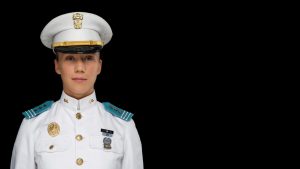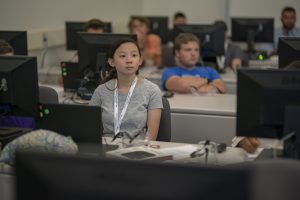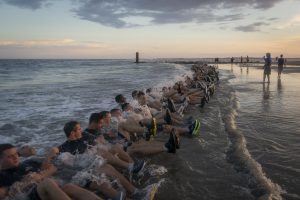At 0800 on a closed weekend, the barracks emits a low rumble as hundreds of cadets in shined brass and pressed wool make their way to inspection. April 21, however, was an open weekend, and cadets were free to do with their morning as they pleased. On any other open weekend, the campus would be nearly silent—those few cadets who remained on campus would be sleeping in, enjoying their day of freedom. But this was no ordinary Saturday. As the sun peaked over the parade deck early that morning, a cacophony of horns, buzzers and cheering filled the air in celebration of the running of the Bulldog Challenge. Similar to a mud run, the Bulldog Challenge is an annual event hosted by the Marine Corps Naval ROTC unit, essentially a 10-kilometer endurance course that borrows events from all facets of the Marine Corps ROTC training experience.
I had the pleasure of running the course as a knob in 2015. Now, as a senior, I looked forward to seeing how the challenge had evolved, as well as how I would fare my second go-round.
Every year, at least a third of the teams participating are, in some way, made up of cadets. While most of the participants who run the Bulldog Challenge do so to challenge themselves, cadets often show up with a greater desire to push their limits. With physical fitness serving as one of the Four Pillars, coupled with the deeply ingrained military culture of The Citadel, the Corps of Cadets proudly embraces a physical culture. On any given day, cadets can be found running, biking, swimming, lifting weights or otherwise pushing themselves to be a little bit better than the day before. The spirit of competition is ever present, so when it is time for the annual Bulldog Challenge, cadets are quick to emerge.
As the buzzer sounded on that early morning in April, I took off at a dead sprint with my classmates—Antonio Molina, Kirk Rizer and Walter Metcalfe—all of us strong, commission-bound cadets who wanted to see just how hard we could push ourselves. Before we even got in sync, we had blown through the obstacle course, picked up sandbags and were making our way to the pool. We kept up our momentum and enthusiasm for at least another mile as we rounded the track, knocked out some pullups and flipped truck tires behind Jenkins Hall. Just like my first run during knob year, the fatigue started to show on the trek from the parade deck to the stadium. But this time, I could handle it a little better. Perhaps because we had completed the challenge before, it was to our advantage to know exactly what the run would feel like. Or perhaps we had better prepared our bodies in the years between our first attempt and today. I prefer to think the answer lies somewhere in the middle.
No matter the level of fitness or mental preparation, the act of carrying sandbags up and down the stadium steps, followed by the carrying of a teammate all the way up the Medical University parking garage, is a teeth-gritting ordeal. When our team of four emerged upon the sunlit roof, it was as though a switch went on, sending us on autopilot. The rest of the course was downhill—like one big sprint. From backtracking down the parking garage, footslogging back to campus, getting wet and sandy behind the rifle range and eventually sprinting back across the parade deck, we barely broke pace. We didn’t even realize we were gasping for breath until a moment after we crossed the finish line.
The Citadel campus on the Saturday afternoon of an open weekend is usually a ghost town, but on the afternoon of April 21, an esprit de corps lingered in the balmy 72-degree air. Exams would begin the following week, and there was studying to be done, but those practicalities were eclipsed by the feeling of elation that comes from a rigorous physical challenge. After all, physical fitness is important for mental endurance, and after the Bulldog Challenge, exams were sure to be a stroll around the parade deck.
Ensign Jon Buckland of Morehead City, North Carolina, graduated in May with a Bachelor of Science degree in Biology. A platoon leader for Palmetto Battery, he was the recipient of the Charleston Navy League Officer Sword. After graduation, he earned a commission in the U.S. Navy.

 A Dream Fulfilled
A Dream Fulfilled Cyber in the Summer
Cyber in the Summer Sunset on Folly Beach
Sunset on Folly Beach